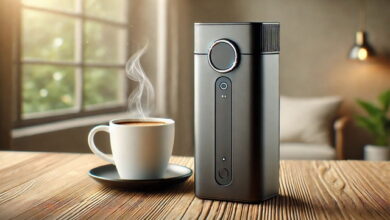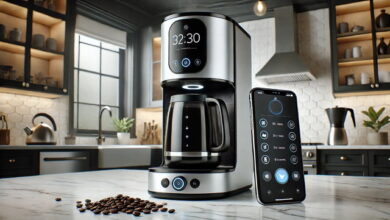Coffee Makers with Eco-Friendly Materials 2025 | Sustainable Choices for Your Perfect Brew
Coffee Makers with Eco-Friendly Materials 2025
As global awareness of environmental issues continues to grow, consumers are increasingly seeking out sustainable alternatives for everyday products. One of the industries where this shift is most apparent is home appliances, particularly coffee makers. In 2025, the trend towards eco-friendly coffee makers is stronger than ever, with both consumers and manufacturers recognizing the need for greener options that reduce waste, conserve energy, and minimize their carbon footprint.
The modern coffee maker is no longer just about brewing the perfect cup; it’s about doing so in a way that aligns with environmental values. From machines made with recycled materials to energy-efficient designs and biodegradable coffee pods, the eco-friendly coffee maker market is evolving rapidly. In fact, for many eco-conscious households, choosing a sustainable coffee maker has become just as important as selecting the right coffee beans.
This shift towards sustainability is being driven by several factors: increasing concerns about climate change, the harmful impact of plastic waste, and a desire to adopt more responsible consumption habits. Whether you’re a dedicated coffee lover or someone looking to reduce your environmental impact, understanding the innovations and benefits of eco-friendly coffee makers is key to making a positive difference—one cup of coffee at a time.
In this guide, we’ll explore the latest advancements in eco-friendly coffee makers, highlight top brands leading the charge, and look ahead at the future of sustainable brewing.
1. Introduction to Eco-Friendly Coffee Makers
As we step into 2025, one of the biggest shifts in consumer behavior is the increased demand for sustainability in everyday products. This change is clearly visible in the coffee maker industry, where the focus is shifting from just brewing a perfect cup of coffee to doing so in an environmentally responsible manner. Coffee makers, once an appliance most people gave little thought to beyond functionality, are now becoming an important part of the eco-conscious household.
In the past few years, the global conversation around climate change, plastic waste, and the impact of human consumption on the planet has gained tremendous momentum. Consumers, particularly millennials and Gen Z, are more aware than ever of the need to reduce their carbon footprints. As part of this trend, they’re seeking out eco-friendly alternatives to everyday products, and coffee makers have not been left out of the equation.
So, what exactly does “eco-friendly” mean in the context of a coffee maker? It goes beyond just being energy-efficient. Today’s eco-friendly coffee makers use sustainable materials like recycled plastics, bamboo, and stainless steel, designed with durability and environmental consciousness in mind. Manufacturers are integrating power-saving features that consume less electricity, while also developing systems that minimize water waste and promote reusability, such as biodegradable coffee pods and reusable filters.
With the eco-friendly revolution now hitting the kitchen appliance industry, 2025 promises to bring exciting innovations to coffee brewing. Whether you’re a dedicated coffee enthusiast or just looking to minimize your environmental footprint, understanding what makes a coffee maker eco-friendly is crucial.
2. What Makes a Coffee Maker Eco-Friendly?
A coffee maker is considered eco-friendly when it incorporates sustainable design elements, from the materials used to the energy efficiency of the machine. Here are the key aspects that make a coffee maker environmentally friendly:
Sustainable Materials
One of the most important factors in determining whether a coffee maker is eco-friendly is the material it’s made from. In the past, coffee makers were predominantly made using virgin plastics and metals, many of which are harmful to the environment both in their production and disposal. However, in recent years, manufacturers have shifted towards using more sustainable alternatives.
For instance, many new coffee makers in 2025 are being built with recycled plastics, reducing the demand for new plastic production and helping to divert plastic waste from landfills. Some companies are even turning to innovative materials like bamboo and other biodegradable substances, which are renewable and less taxing on the environment. Bamboo is particularly popular because it grows quickly, doesn’t require pesticides, and is completely biodegradable, making it an ideal material for eco-friendly products.
Stainless steel is another material that’s commonly used in sustainable coffee makers. While it may not be biodegradable, stainless steel is incredibly durable and can be recycled, which gives it a much longer life cycle compared to traditional plastic models. This means that a stainless steel coffee maker can last for years, reducing the frequency of replacement and the waste that comes with discarding old machines.
Energy-Efficient Brewing Systems
The second pillar of an eco-friendly coffee maker is energy efficiency. Coffee makers are often left plugged in for long periods, using electricity even when they’re not in use. In 2025, energy-efficient coffee makers are designed to minimize this waste through smart technology that automatically shuts off the machine when it’s not being used. Some models are also equipped with energy-saving modes, ensuring that they consume only the necessary amount of electricity while brewing.
Furthermore, innovations like insulated carafes and advanced heating elements are helping coffee makers use less energy without sacrificing performance. An insulated carafe, for example, can keep coffee warm for hours without the need for continuous heating, which not only conserves energy but also preserves the flavor of the coffee. These small, thoughtful features contribute significantly to the energy-saving potential of eco-friendly coffee machines.
Many manufacturers are also working to meet stringent energy certification standards, such as Energy Star. These certifications ensure that the coffee maker operates efficiently, reducing its overall environmental impact. As consumers grow more eco-conscious, an increasing number of coffee makers in 2025 will boast these energy certifications, giving buyers confidence in their sustainability credentials.
Reusable Filters and Biodegradable Coffee Pods
Single-use products like disposable coffee filters and plastic coffee pods contribute enormously to the global waste crisis. In response to this, many of the eco-friendly coffee makers entering the market in 2025 are designed to work with reusable filters and biodegradable pods.
Traditional coffee filters are often made from bleached paper, which not only uses harmful chemicals in production but also contributes to deforestation. Reusable filters, on the other hand, are typically made from stainless steel or other long-lasting materials, eliminating the need for single-use filters altogether. These reusable filters can last for years, dramatically cutting down on waste and saving money in the long term.
Similarly, the rise of biodegradable coffee pods has been one of the most exciting developments in the coffee industry. The convenience of single-serve coffee pods has made them incredibly popular, but they also generate a staggering amount of waste. In 2025, more coffee makers will be compatible with compostable coffee pods, which break down naturally without leaving harmful microplastics behind. This is a game-changer for single-serve coffee fans who want to reduce their environmental impact.
Durability and Repairability
Another aspect of sustainability that is becoming increasingly important is the durability and repairability of coffee makers. A well-built machine that lasts for many years is far more sustainable than a cheaper model that breaks down after a year or two and ends up in a landfill. Some manufacturers are designing their coffee makers with modular components, meaning that if one part breaks, it can be easily replaced without discarding the entire machine. This extends the life of the appliance and reduces waste.
3. Top Brands Offering Eco-Friendly Coffee Makers in 2025
The demand for eco-friendly coffee makers has prompted many leading brands to adapt and innovate. As we enter 2025, a number of companies are stepping up to the challenge by offering products that prioritize sustainability without sacrificing quality or performance. Whether through the use of recycled materials, energy-efficient technology, or innovative design, these brands are leading the way in environmentally conscious coffee brewing.
- Keurig’s Green Initiative
Keurig, one of the most well-known names in the coffee machine industry, has made significant strides in its eco-friendly approach. Historically criticized for its single-use plastic pods, Keurig has introduced compostable and recyclable pods in response to growing environmental concerns. In 2025, Keurig is focusing on creating machines with recycled plastics and energy-saving features, positioning itself as a leader in sustainable coffee solutions.
Their newest models come equipped with auto-off settings, energy-saving brew cycles, and the ability to work with biodegradable coffee pods. These changes reflect the company’s commitment to reducing plastic waste and its overall carbon footprint. By offering these eco-friendly features while maintaining the convenience that made them popular, Keurig is ensuring that sustainability doesn’t come at the cost of user experience.
- Nespresso’s Push for Sustainability
Nespresso has long been associated with luxury coffee brewing, but in recent years, it has turned its attention to sustainability as well. The company has developed a comprehensive recycling program for its aluminum capsules and introduced a range of machines designed with eco-friendly materials. By 2025, Nespresso aims to have all of its coffee machines meet strict environmental standards, with a particular focus on reducing energy consumption.
Nespresso’s efforts don’t stop at the machines themselves. The brand is also investing in sustainable coffee sourcing, working directly with farmers to ensure that its coffee is grown and harvested in environmentally responsible ways. Through partnerships and certifications, Nespresso is making sure that the entire coffee experience—from bean to brew—aligns with its sustainability goals.
- Breville’s Durable and Efficient Coffee Makers
Breville is another brand making waves in the eco-friendly coffee market. Known for its high-quality espresso machines, Breville has taken steps to design products that are not only energy-efficient but also built to last. By 2025, the brand is focusing on creating durable machines with stainless steel components and recyclable packaging.
Breville’s commitment to durability extends to repairability as well. The company offers replacement parts and repair services, encouraging customers to maintain their machines rather than replace them. This focus on longevity makes Breville’s machines a smart choice for eco-conscious consumers who want to reduce waste.
- New Players Entering the Market
Alongside established brands, several smaller companies are emerging with innovative eco-friendly coffee makers. These new players are taking sustainability to the next level, offering machines made from cutting-edge materials like biodegradable plastics and renewable resources. By pushing the boundaries of what’s possible in coffee maker design, these startups are helping to shape the future of eco-conscious brewing.
4. The Role of Recycled Materials in Coffee Maker Design
One of the most significant shifts in the coffee maker industry has been the move towards using recycled materials. In 2025, more companies than ever are incorporating recycled plastics and metals into their designs, reducing the need for virgin materials and helping to close the loop on waste. But what does this mean for consumers and the environment?
- Reducing Plastic Waste
Plastic waste is one of the most pressing environmental issues of our time. With millions of tons of plastic ending up in landfills and oceans each year, finding ways to reduce plastic consumption is critical. Many coffee maker manufacturers are addressing this issue by using recycled plastics in their machines. This not only diverts waste from landfills but also reduces the demand for new plastic production, which is energy-intensive and polluting.
By 2025, it’s common to find coffee makers that are made from 50% or more recycled plastics. These materials are carefully processed to ensure they meet safety and performance standards, so consumers can enjoy the same high-quality experience while making a more sustainable choice.
- Metals and Their Role in Sustainability
Metals, particularly stainless steel, are another key material used in eco-friendly coffee makers. While metals are not biodegradable, they are highly recyclable, making them an excellent choice for durable products that are designed to last. Many eco-conscious coffee makers in 2025 feature stainless steel components that can be easily recycled at the end of the product’s life cycle.
Additionally, the use of metals in coffee makers often enhances their longevity. A machine made from stainless steel is less likely to break or wear out over time, reducing the need for frequent replacements and minimizing waste. This makes it a highly sustainable choice for both manufacturers and consumers.
- Recycled Materials in Packaging
In addition to using recycled materials in the coffee makers themselves, many brands are also focusing on sustainable packaging. By 2025, it is increasingly common for coffee makers to come in packaging made from recycled cardboard or biodegradable materials. This reduces the environmental impact of the product from the moment it reaches the consumer, supporting a more sustainable supply chain overall.
5. Energy-Efficient Coffee Makers and Power-Saving Features
Energy efficiency has become one of the most critical factors in the design of eco-friendly coffee makers. As concerns over climate change and energy consumption grow, consumers are looking for appliances that minimize their environmental impact. In 2025, coffee makers are incorporating cutting-edge technology to ensure that brewing a cup of coffee doesn’t require unnecessary power consumption.
- Smart Technology for Energy Conservation
One of the most exciting advancements in eco-friendly coffee makers is the integration of smart technology. Many of the latest models come with built-in energy-saving features, such as automatic shut-off timers and programmable brewing cycles. This ensures that the machine only uses energy when it’s needed, and powers down when idle.
Some machines also offer energy-efficient brew cycles that heat water more quickly and at lower temperatures, reducing the amount of energy required to brew each cup. These features not only help to lower electricity bills but also reduce the overall carbon footprint of coffee consumption.
- Energy Certifications and Standards
To make it easier for consumers to identify eco-friendly coffee makers, many manufacturers are now pursuing energy certifications like Energy Star. Machines that meet these standards are rigorously tested to ensure they use less electricity than traditional models, making them a more sustainable option.
In 2025, energy-certified coffee makers are becoming the norm rather than the exception. This trend reflects both consumer demand for greener products and the coffee maker industry’s commitment to reducing its environmental impact.
- The Role of Insulation in Energy Savings
Another important feature of energy-efficient coffee makers is insulation. Many models now come with insulated carafes, which keep coffee hot for hours without the need for a heating plate. This reduces the amount of energy consumed and also preserves the flavor of the coffee, offering both environmental and practical benefits.
6. Biodegradable Coffee Pods and Filters: A Green Revolution
The rise of single-serve coffee pods in recent years has created a major convenience for coffee drinkers but also led to a significant environmental problem. Billions of plastic pods end up in landfills each year, contributing to pollution and waste. However, as sustainability has become a priority, manufacturers are developing biodegradable coffee pods and reusable filters, offering a solution that aligns with eco-friendly living.
- The Environmental Impact of Single-Use Coffee Pods
Traditional coffee pods are made from non-recyclable plastics and aluminum, which take hundreds of years to decompose in landfills. The convenience of single-serve coffee has been overshadowed by the massive environmental toll it takes, as most of these pods are thrown away after just one use. With billions of pods sold worldwide every year, their cumulative impact is staggering.
In response to this issue, companies in 2025 are introducing compostable and biodegradable coffee pods. These pods are made from plant-based materials that break down naturally in composting facilities, reducing the amount of waste that ends up in landfills. By switching to biodegradable pods, coffee drinkers can still enjoy the convenience of single-serve brewing while making a more sustainable choice.
- Reusable Coffee Filters: A Waste-Free Alternative
Another way to cut down on coffee-related waste is through the use of reusable filters. Traditional coffee filters are typically made from bleached paper, which requires energy-intensive production processes and contributes to deforestation. Moreover, these filters are often thrown away after just one use, adding to the waste burden.
Reusable filters, made from stainless steel or mesh, are a more sustainable option. They eliminate the need for disposable paper filters and can be used for years, dramatically reducing waste. In 2025, an increasing number of coffee makers are designed to work with reusable filters, providing eco-conscious consumers with a greener way to brew.
- The Future of Biodegradable Coffee Pods
By 2025, biodegradable coffee pods are no longer a niche product. Major brands like Keurig and Nespresso have introduced lines of compostable pods that work with their machines. Some manufacturers are even partnering with local composting facilities, making it easier for consumers to properly dispose of their used pods.
The shift to biodegradable coffee pods represents a significant step forward in reducing the environmental impact of single-serve brewing. As more companies adopt these sustainable alternatives, it’s likely that the days of plastic pods will soon be behind us.
7. The Impact of Coffee Makers on the Environment: Why It Matters
Coffee is one of the most widely consumed beverages in the world, and the machines we use to brew it have a substantial environmental impact. From the energy they consume to the materials they’re made from, coffee makers contribute to carbon emissions, resource depletion, and waste generation. Understanding the environmental footprint of coffee makers is crucial for making informed decisions that support sustainability.
- The Carbon Footprint of Coffee Machines
Like many household appliances, coffee makers have a carbon footprint that results from their manufacturing, usage, and disposal. The energy used during the brewing process, the materials required for production, and the waste generated by single-use coffee pods all contribute to the machine’s overall environmental impact.
Energy consumption is a key factor in the carbon footprint of coffee makers. Machines that are left plugged in or have inefficient heating elements consume more electricity, leading to higher carbon emissions. By choosing an energy-efficient coffee maker, consumers can significantly reduce their environmental impact over time.
Additionally, the materials used in coffee makers—such as plastic and metal—require energy to produce and transport. Machines made from recycled or sustainable materials have a lower carbon footprint because they reduce the demand for new resources and minimize waste. In 2025, the growing availability of eco-friendly coffee makers allows consumers to opt for more sustainable options.
- Waste from Non-Recyclable Parts
In addition to their carbon footprint, many coffee makers generate waste through non-recyclable components. Machines with plastic parts that cannot be recycled or repaired often end up in landfills, contributing to the growing problem of electronic waste. The rise of disposable coffee pods has further exacerbated this issue, as billions of plastic pods are discarded each year.
To combat this problem, manufacturers are focusing on making their coffee makers more durable and repairable. By extending the life of the machine and ensuring that it can be recycled at the end of its life cycle, companies are helping to reduce the environmental impact of their products. In 2025, coffee makers designed with sustainability in mind will increasingly feature replaceable parts and recyclable materials.
- The Importance of Life-Cycle Analysis
One of the most effective ways to measure the environmental impact of a coffee maker is through a life-cycle analysis (LCA). This analysis takes into account the entire life of the product, from the extraction of raw materials to its disposal. By understanding the full life-cycle impact, manufacturers and consumers can make more informed decisions about which products are truly sustainable.
In 2025, many eco-conscious coffee makers are designed with life-cycle sustainability in mind. This means that manufacturers consider not only how the machine performs but also how it is made, how long it lasts, and what happens to it when it is no longer usable. By choosing products that are built for durability, made from sustainable materials, and easily recyclable, consumers can significantly reduce their environmental footprint.
8. How to Choose the Best Eco-Friendly Coffee Maker in 2025
With so many eco-friendly coffee makers on the market in 2025, choosing the best one for your needs can feel overwhelming. However, by focusing on a few key factors—materials, energy efficiency, and waste reduction—you can make an informed decision that aligns with your sustainability goals.
- Look for Sustainable Materials
The first thing to consider when choosing an eco-friendly coffee maker is the materials it’s made from. Machines made from recycled plastics, stainless steel, or renewable resources like bamboo are more sustainable than those made from virgin plastic. These materials reduce the demand for new resources and minimize waste.
Additionally, consider the packaging that the coffee maker comes in. Many eco-friendly brands use recycled or biodegradable packaging, further reducing the product’s environmental impact.
- Prioritize Energy Efficiency
Energy efficiency is another important factor to consider. Look for coffee makers with energy-saving features, such as automatic shut-off functions, insulated carafes, and programmable brewing cycles. These features help reduce electricity consumption and lower your carbon footprint.
Energy certifications, such as Energy Star, can also indicate that a coffee maker meets strict energy-efficiency standards. In 2025, many eco-friendly machines come with these certifications, making it easier for consumers to identify the most sustainable options.
- Consider Waste Reduction Features
Finally, consider the machine’s approach to waste reduction. Coffee makers that work with reusable filters and biodegradable coffee pods can dramatically reduce the amount of waste generated by your daily coffee routine. Reusable filters eliminate the need for paper filters, while compostable pods break down naturally and don’t contribute to landfill waste.
By choosing a machine with waste-reduction features, you can enjoy your coffee knowing that you’re minimizing your environmental impact.
- Balance Sustainability with Your Needs
While it’s important to prioritize sustainability, it’s also essential to find a coffee maker that fits your lifestyle and brewing preferences. Consider factors like the size of the machine, the brewing capacity, and whether it meets your coffee needs (e.g., single-serve, drip, or espresso). Fortunately, in 2025, there are eco-friendly options available across all categories, so you can find a machine that meets both your environmental and personal requirements.
9. Future Trends in Eco-Friendly Coffee Makers Beyond 2025
As we look beyond 2025, the future of eco-friendly coffee makers seems more innovative and sustainable than ever. Companies are pushing the boundaries of design and technology to create machines that are not only better for the environment but also offer enhanced convenience and customization for consumers. Here are some of the key trends that we can expect to shape the future of coffee makers in the coming years.
- Smart Coffee Machines with Sustainability Features
Smart home technology is becoming more integrated into everyday appliances, and coffee makers are no exception. In the future, we can expect to see coffee makers equipped with even more advanced smart features designed to improve energy efficiency. Imagine a coffee maker that syncs with your phone or smart home system to brew coffee only when you’re ready for it, reducing energy waste.
These smart machines will also be able to monitor water usage, alert you when maintenance is required, and even suggest ways to improve your brewing efficiency. The goal is to create a seamless experience that conserves resources while delivering a perfect cup of coffee every time. The more data these machines can gather, the more they can optimize brewing times, temperatures, and energy consumption to ensure that your coffee maker operates in the most sustainable way possible.
- Circular Economy in Coffee Maker Design
The concept of a circular economy—where products are designed to be reused, repaired, and recycled—is gaining traction in many industries, and coffee makers are no different. Future coffee makers are likely to be built with modular components, allowing users to easily replace parts rather than discarding the entire machine when something breaks. This not only reduces waste but also extends the lifespan of the machine, making it a more sustainable option.
In addition, manufacturers will continue to prioritize recycled materials in their designs, further reducing the environmental impact of producing new coffee makers. Some companies may even offer take-back programs, allowing consumers to return their old machines for recycling or refurbishment, closing the loop on waste.
- Zero-Waste Coffee Makers
Looking further into the future, we may see the rise of zero-waste coffee makers—machines that produce no waste at all, from the brewing process to the disposal of used coffee grounds. Some manufacturers are already experimenting with compostable coffee grounds collection systems, which turn used grounds into fertilizer, eliminating the need for them to be discarded.
These machines may also incorporate advanced water filtration and purification systems that reduce water waste and allow for more efficient brewing. As consumers continue to demand eco-friendly solutions, the concept of a zero-waste coffee maker may become a reality in the not-too-distant future.
10. Conclusion: The Growing Need for Eco-Friendly Coffee Solutions
The coffee maker industry is undergoing a transformative shift as sustainability becomes a top priority for both manufacturers and consumers. In 2025, eco-friendly coffee makers are more accessible, efficient, and innovative than ever before. From the use of recycled materials and energy-saving technologies to biodegradable coffee pods and reusable filters, these machines are helping reduce the environmental impact of coffee brewing.
The importance of making eco-conscious choices when it comes to household appliances cannot be overstated. Coffee is a daily ritual for millions of people around the world, and the machines we use to brew it have a lasting effect on the planet. By choosing an eco-friendly coffee maker, you’re not only enjoying a great cup of coffee but also making a positive contribution to environmental sustainability.
As we look toward the future, it’s clear that the coffee industry will continue to evolve in exciting ways. Whether through the integration of smart technology, the adoption of circular economy principles, or the development of zero-waste machines, the next generation of coffee makers will be designed with both convenience and the planet in mind.
So, as you explore the options available in 2025 and beyond, consider how your coffee choices can help support a greener future. After all, the journey to sustainability starts with small, everyday decisions—like the coffee maker you choose for your home.








